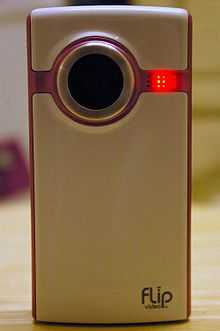Flip Video


The Flip Video cameras are a series of tapeless camcorders for digital video created by Pure Digital Technologies,[1] a company bought by Cisco Systems in March 2009;[2] variants included the UltraHD,[3] the MinoHD,[4] and the SlideHD.[5] Production of the line of Flip video cameras ran from 2006 until April 2011.[6]
Features
All FlipHD camcorders digitally record at High-definition video 1280 x 720 resolution using H.264 video compression, Advanced Audio Coding (AAC) audio compression and the MP4 file format as of September 20, 2010, increased from the 640 x 480 resolution of earlier models[7] The MinoHD and SlideHD models have an internal Lithium-Ion Rechargeable Battery included, and with the UltraHD 1 hr., a battery pack (the camera is capable of using 2 AA batteries), or with the 2 hr. UltraHD, a lithium ion battery (can use 3 AAA batteries).
All models lack a memory card extension slot but the UltraHD 2 hr. has a storage solution via FlipPort, and all models can be connected to a computer with a pop-out USB connector, without the need for a cable. It provides automatic gain, digital zoom, monaural sound, and a clip-navigation interface with a D-pad and two control buttons. The Flip UltraHD comes in 4GB (1 hour) and 8GB (2 hour) models for $149.99 and $199.99 respectively. The Flip UltraHD 1 hour is available in multiple colors of white, blue, pink, and also a custom design. The 2 hr. UltraHD can be bought in black, white, or a custom design. The UltraHD 1 hr. does not have Image Stabilization whereas the 2 hr. UltraHD does. The UltraHD 2 hr. has a new feature called FlipPort. With FlipPort, users can plug in external accessories. There is no way to use any model to record or play from other source than from objective.
All Flip cameras include the required video player and 3ivx codec software in the camera itself rather than providing an external CD-ROM installer. FlipShare can be installed once it is connected. For all models as of September 20, 2010, a HDMI cable can be bought from their store for watching the HD videos on HDTV screens.
As of September 20, 2010, all Flip Video models can be customized. (This means users send them a picture which they "paint" on the front side of the camera). Accessories for the Flip Video camera include an underwater case, a tripod, a bicycle helmet attachment, and a wool case (Mino camcorders) or soft pouch (Flip UltraHD), a rechargeable battery replacement for the UltraHD (1 hr. AA rechargeable, 2 hr. AAA rechargeable lithium ion) and also an extension cable to connect the camera in hard to reach places which comes in different colors.[8]
Flip Video's accompanying software is called FlipShare. After the release of version 5.6, FlipShare no longer includes a function to convert video to WMV format. While this has been acknowledged by Cisco as a defect, a fix has yet to be announced. Furthermore, there is no way to revert to a previous version once the new software is installed.
History
The first version was originally released as the "Pure Digital Point & Shoot" video camcorder on May 1, 2006[9] as a reusable follow-on to the popular CVS One-Time-Use Camcorder, a Pure Digital product sold through CVS/pharmacy stores that was designed for direct conversion to DVD media. This was in turn a line extension of previous digital disposable camera products (sold initially through Ritz Camera and associated brands under the Dakota Digital name). The camcorder was then renamed as the Flip Video a year later.[10] On September 12, 2007, the Flip Ultra was released.[11] The Flip Ultra was the best-selling camcorder on Amazon.com after its debut, capturing about 13% of the camcorder market.[12] Flip products received an unusually large advertising campaign, including product placement,celebrity endorsements, and sponsoring of events such as concert tours[13][14][15] during their introduction. From 2009, and through the Cisco takeover, the Flip range was sold in Europe by Widget UK[16]
Models
- Pure Digital One-Time-Use Camcorder (20 minutes - model 200)
- Pure Digital Point & Shoot Video Camcorder (30 minutes - 225), Codenamed: Saturn 2.5
- Pure Digital Point & Shoot Video Camcorder (30 minutes - PSV-351; 60 minutes - PSV-352), Codenamed: Saturn 3.5
- Pure Digital Flip Video (30 minutes - F130/PSV-451; 60 minutes - F160/PSV-452), Codenamed: Austin
- Flip Video Ultra (30 minutes - F230/PSV-551; 60 minutes - F260/PSV-552) Codenamed: Chicago
- Flip Video Ultra II (2 hour - U1120), Codenamed: Phoenix SD
- Flip Video UltraHD (2 hours - U2120), Codenamed: Phoenix HD
- Flip Video UltraHD II (1 hour - U260)
- Flip Video UltraHD III (2 hours - U32120)
- Flip Video Mino (1 hour - F360), Codenamed: Fremont
- Flip Video MinoHD (1 hour - F460), Codenamed: Newton
- Flip Video MinoHD II (2 hours - M2120), Codenamed: Quantico
- Cisco Flip MinoPro (4 hours - MP2240)
- Flip Video MinoHD III (1 hour - M3160; 2 hours - M31120)
- Flip Video SlideHD (4 hours - S1240), Codenamed: Jamestown
- Flip Video
Specs about the Ultra Models can be found on the Cisco Site.
Mino
A smaller version of the Flip, the Flip Video Mino, was released on June 4, 2008.[17] The Mino captured video in 640x480 resolution at 30 frames per second. On launch it retailed for about US$180 in the United States,[18] providing about 60 minutes of video recording capability with 2 GB flash memory capacity.
The Flip MinoHD third was released on September 20, 2010. It featured HD recording capabilities in the same dimensions as the second generation MinoHD, but not the same as the original first generation MinoHD. The only major change in the MinoHD third generation is Image Stabilization. Also released on September 20, 2010 was a 4 GB, MinoHD with one hour of recording capability. Both 2010 MinoHD cameras had Image Stabilization. The one-hour version retailed for US$179 MSRP and the two-hour version retailed for US$229 MSRP.
A free Mino was made available to all audience members at YouTube Live due to Flip Video's sponsorship of the event. A station was even set up so people could upload the videos to YouTube.
FlipShare TV
The makers of the Flip Video family of camcorders have launched a "new innovation" in home video sharing with the introduction of the FlipShare TV. With built-in wireless capability, Flipshare TV allows the user to connect the TV base to their TV, plug in the USB transmitter key to their computer and view their Flipshare library.
Acquisition and shutdown by Cisco
It was announced on March 19, 2009, that Cisco Systems had acquired Pure Digital Technologies, the maker of Flip Video for $US590 million in stock. The acquisition was completed on May 21, 2009.
On April 12, 2011, Cisco announced that it "will exit aspects of its consumer business" which includes shutting down the Flip.[19]
Some observers suggested that the Flip was facing growing competition from camera phones, particularly smartphones (which have disrupted point-and-shoot cameras, wristwatches, alarm clocks, portable music players, and GPS devices) that have recently added HD movie capability. Even though contrary to popular perception, however, smartphones as of 2011 are still a small fraction of overall worldwide sales of cell phones (most which do not have high-definition video), and the Flip was still selling strongly when its discontinuation was announced.[20] Another suggested reason was because consumer hardware was not part of Cisco's core businesses of services and software, furthermore the profit margins on consumer electronics were narrow.[6]
As Cisco shut down the Flip business instead of divesting of it, it has been suggested that the patents and other intellectual property from the acquisition could have proved valuable to Cisco's videoconferencing businesses in the future.[21][22]
As of 2012, the only aspect of the Flip Video that remains is the USB plug. Sony's HDR-PJ series camcorders incorporate a pull-out USB plug to allow videos to be uploaded to a computer in the same manner as the Flip Video.
References
- ↑ Boehret, Katherine (September 12, 2007). "An Easier Way to Make and Share Videos.". Wall Street Journal. Retrieved 2008-02-19.
- ↑ Ashlee Vance (March 19, 2009). "A Tiny Camcorder Has a Big Payday". The New York Times. Retrieved 2009-03-23.
- ↑ Flip UltraHD - High definition video cameras & reviews from Flip Video | Cisco
- ↑ Flip MinoHD - High definition video cameras & reviews from Flip Video | Cisco
- ↑ Flip Slide HD - High definition video cameras & reviews from Flip Video | Cisco
- ↑ 6.0 6.1 For Flip Video Camera, Four Years From Hot Start-Up to Obsolete
- ↑ Flip Video - See the Specs
- ↑ The Flip Support pages - Accessories
- ↑ Mossberg, Walter; Katherine Boehret (May 3, 2006). "The Video Camera Revised". Wall Street Journal. Retrieved 2008-06-04.
- ↑ Pure Digital Technologies Unveils Flip Video
- ↑ Pure Digital Technologies introduces the Flip Video Ultra Series
- ↑ Pogue, David (March 20, 2008). "Camcorder Brings Zen to the Shoot.". New York Times. Retrieved 2008-03-20.
- ↑ http://awakeninteractive.com/index.cfm/blog/as-the-lines-blur-digital-agencies-are-taking-lead/[]
- ↑ http://www.market7.com/blog/2011/04/27/simple-or-versatile-flip-demise-indicates-answer-is-now-both/
- ↑ http://www.fierceonlinevideo.com/story/ciscos-flip-video-microcam-focus-multimillion-ad-campaign/2009-11-09
- ↑ Widget UK to take over distribution for Flip Video
- ↑ Press release
- ↑ Flip Video - See the Specs
- ↑ Press Release - Cisco Restructures Consumer Business
- ↑ David, Pogue (April 14, 2011). "The Tragic Death of the Flip". NY Times. Retrieved 27 August 2011.
- ↑
- ↑ Pogue, David (April 14, 2011). "The Tragic Death of the Flip". The New York Times.
External links
| Wikimedia Commons has media related to Flip video cameras. |
- Flip Video homepage
- Specifications of all 3 video cameras
- Cisco buys Flip Video maker
- Distribution outside USA
- Cisco to shutter Flip camera business